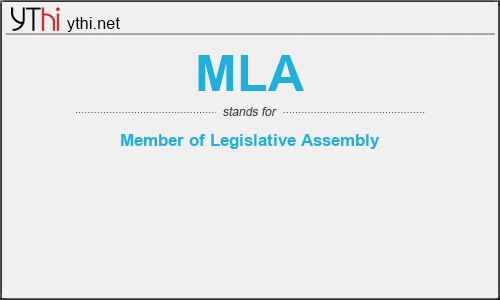What does MLA mean? What is the full form of MLA?
The full form of MLA is Member of Legislative Assembly.
A Member of the Legislative Assembly (MLA) is a representative elected by the voters of an electoral district (constituency) to the legislature of State government in the Indian system of government. From each constituency, the people elect one representative who then becomes a member of the Legislative Assembly (MLA). Each state has between seven and nine MLAs for every Member of Parliament (MP) that it has in the Lok Sabha, the lower house of India’s bicameral parliament. There are also members in three unicameral legislatures in Union Territories: the Delhi Legislative Assembly, Jammu and Kashmir Legislative Assembly Puducherry Legislative Assembly.
An MLA (Member of the Legislative Assembly) is elected by the public in his/her constituency or electoral division, to serve as a representative in the Manitoba Legislative Assembly.
ROLE
An MLA may be required to fulfill as many as four distinct roles:
The role of Legislator involves understanding the spirit of existing laws, planning new laws, and studying, discussing and then supporting or opposing the enactment of new laws.
As a Representative of his or her constituency, a Member may voice concerns on behalf of constituents, represent viewpoints or intercede and assist in problem solving.
An MLA is also a Member of an elected party caucus. In this function, he or she may be involved in planning and orchestrating strategy in the House, supporting the caucus and its decisions, and developing expertise in given subject areas.
Depending on his/her party’s political fortunes, the MLA may serve as a Cabinet Minister or Opposition Critic.
MLA DUTIES
Members of the Legislative Assembly divide their time between their constituencies and their work in the Assembly. MLAs duties will vary, depending on whether he/she is a Member of Cabinet, a Member of the Opposition, or a Government Backbencher.
Opposition Members spend much of their time researching and asking questions in the House regarding their constituencies and critic areas. Both Opposition Members and Government Backbenchers present Petitions, Resolutions, and Private Members’ Bills to the House.
MLAs who are Ministers of the Crown (Cabinet Members) spend much of their time overseeing the operations of their assigned departments. Cabinet Ministers must be prepared to answer questions from the Opposition, put forward Government Bills, and deal with the Estimates and Annual Reports of their departments.
MLAs also serve as Members of various committees. Committee membership is allocated to the political parties in approximately the same proportion as their representation in the House.
Constituents encountering problems within their division, or having problems dealing with government departments, agencies, etc. often refer to their MLA for assistance. Much of an MLA’s time is spent handling their constituents’ individual problems, answering questions and concerns, and keeping aware of the prevailing opinion of the constituency.
MLAs keep in touch with their constituents by personal contact, by phone, in writing, through meetings, and by the two annual household mailings they are entitled to send.
Every MLA may open an office in his or her constituency.
MLA
means
Member of Legislative Assembly![]()
Translate Member of Legislative Assembly to other language.


Leave a Reply
You must be logged in to post a comment.